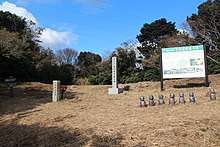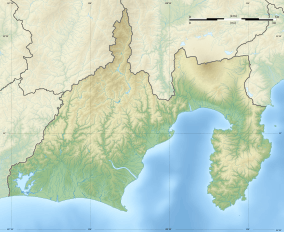Ōchiwatoge temple ruins
Ōchiwatoge temple ruins (大知波峠廃寺跡, Ōchiwatoge haji ato) is an archaeological site with the ruins of a Heian period Buddhist temple located in what is now the city of Kosai, Shizuoka, Japan. The temple no longer exists, but the temple grounds were designated as a National Historic Site by the Japanese government in 2001. [1]
| Ōchiwatoge temple ruins | |
|---|---|
大知波峠廃寺跡 | |
 Ōchiwatoge temple ruins | |
| Religion | |
| Affiliation | Buddhist |
| Status | ruins |
| Location | |
| Location | Kosai, Shizuoka |
| Country | Japan |
 Shown within Shizuoka Prefecture  Ōchiwatoge temple ruins (Japan) | |
| Geographic coordinates | 34°46′55.3″N 137°28′59.9″E |
Overview
The site is located at an altitude of 340 meters in the Ōchiwa Pass which connects the city of Kosai in Shizuoka Prefecture with the city of Toyokawa in Aichi Prefecture, and overlooks Lake Hamana. The area is maintained as part of a hiking course today. It is approximately one hour 45 minutes on foot from Tenryū Hamanako Line Chibata Station.
The presence of ruins in the Ōchiwa Pass was known for many years; however, there was no mention of any settlement in literature, and the nature of these ruins was unknown. Starting in 1989, the Kosai City Board of Education conducted excavation surveys for seven years, discovering the foundation of twelve buildings, remnants of a pond with gardens. and monumental gate, built in two terraces on the hillside. Of these building, five were clearly Buddhist temple structures, the largest of which was a 7x4 bay hall, with dimensions of 16 x 11 meters. Numerous pottery and ceramic shards were uncovered, including 445 examples with ink-painted inscriptions, from which the site could be dated from the 8th century through the end of the 11th century. From the inscriptions, it appears that this was either a Tendai or Shingon temple. A small chapel was erected on top of the earlier ruins in the latter half of the 12th century.
The site has been backfilled, and there are no ruins visible today.
References
- "大知波峠廃寺跡" (in Japanese). Agency for Cultural Affairs.
External links
- Kosai City site (in Japanese)